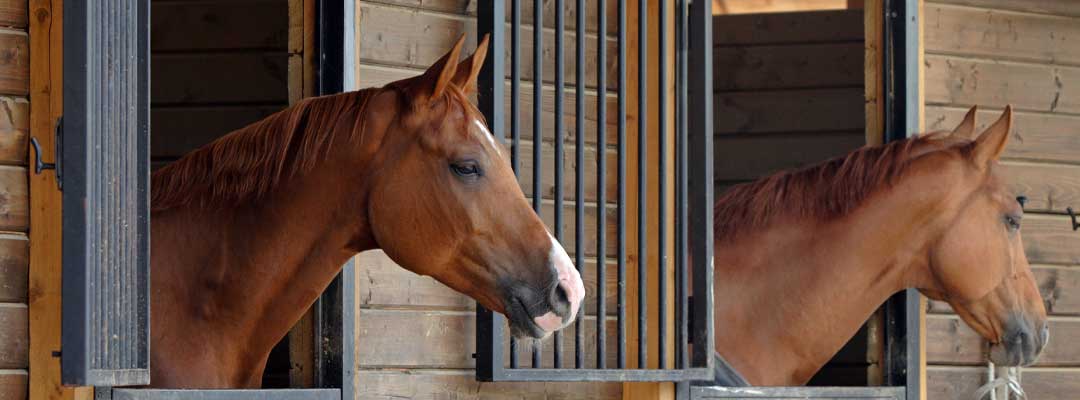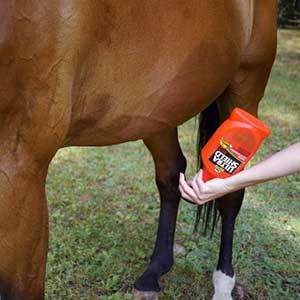While enjoying a ride with your horse on a perfect, sunny day, you sink into the saddle in pure relaxation. Then suddenly, a horse fly lands on your horse’s rear end. He swishes his tail and the tranquility of just moments ago is halted as your horse bucks mid-air to rid the biting pest.
Can you relate?
Creating a completely fly-free barn for you and your horse, especially during the middle of summer, can seem like mission impossible. Flies can be relentless! However, there are six simple strategies you can implement to reduce the fly and insect population at your horse barn. Control their wicked, winged ways with these top tips.
1. PROACTIVELY REMOVE MANURE.
Remove manure and wet bedding daily to keep horse stalls clean. Reduce fly-attracting odors and eliminate the warm, moist environment where flies often lay eggs and use as a food source.
Regularly remove manure piles off-site from pastures. You also can spread or rake manure over fields and large paddocks to help dry them out to create a less-ideal environment for egg-laying flies.
2. HANG FLY TRAPS AND FLY TAPE.
Use horse fly traps to lure flies away from the barn. Hang traps away from the barn, so that horseflies are lured away from the barn and your horses. Hang the traps at least four feet above the ground and follow the manufacturer’s directions for placement.
To catch flies inside the barn, hang strips of fly tape from higher locations like ceilings or rafters.
3. INSTALL INDOOR FANS.
Flies can be easily deterred by using ceiling and portable fans, as circulating air makes it difficult for the flies to travel and land. Angling a livestock fan or barn fan over your horse’s stall can help prevent flies from landing on your horse.
Ensure that fans and power cords are specifically designed for agricultural use to reduce fire risk, and keep them safely out of a horse’s reach.
4. MAINTAIN A TIDY BARN.
Remove any dropped grain, equine supplements or medications from stalls and feed room areas. Empty and scrub feed tubs and water buckets regularly.
Make sure all garbage cans inside or near your barn have tight-fitting lids to prevent flies from accessing the trash as a food source. Regularly remove garbage from trash cans and clean them to remove residue and unpleasant aromas.
5. USE PREMISE AND FLY SPRAYS.
Use a premise spray to quickly knock down adult flies and other barn-residing insects, as well as help deter new ones from entering the area. Some on-horse fly sprays double as a premise spray, allowing you to use them in areas of your barn to kill and repel gathering flies.
Fly spray for horses offers a quick and easy solution for protection against flies. Ensure your horse is clean so the spray sticks to the hair, not to dirt or mud, and cover every part of the horse’s body evenly.
Start applying fly spray slowly and low on the legs, as some horses may at first be fearful of the noise. To prevent flies from your horse’s face and ears, apply fly spray to a cloth and then wipe it onto the areas, carefully, to avoid the eyes.
6. ENSURE PROTECTION THROUGH FLY GEAR.
Fly gear offers more than just protection against flies; it also offers UV protection for horses. Some brands of sheets and masks will block more than 70 percent of harmful UV rays. A wide variety of fly protection gear is available to keep horses safe from a fly’s harmful and painful bite, such as a fly sheet, fly mask and fly boots for horses.
Check fly masks, fly blankets and fly boots regularly to make sure that they are fitting correctly and not rubbing or causing any soreness.
Make fly season more enjoyable for you and your horse through effective fly control methods. Continue reading on this subject with advice from two industry professionals -- a head trainer at a Miami jumping barn, and a professional rodeo cowboy, as they share top tips for a more peaceful, fly-free stable.




